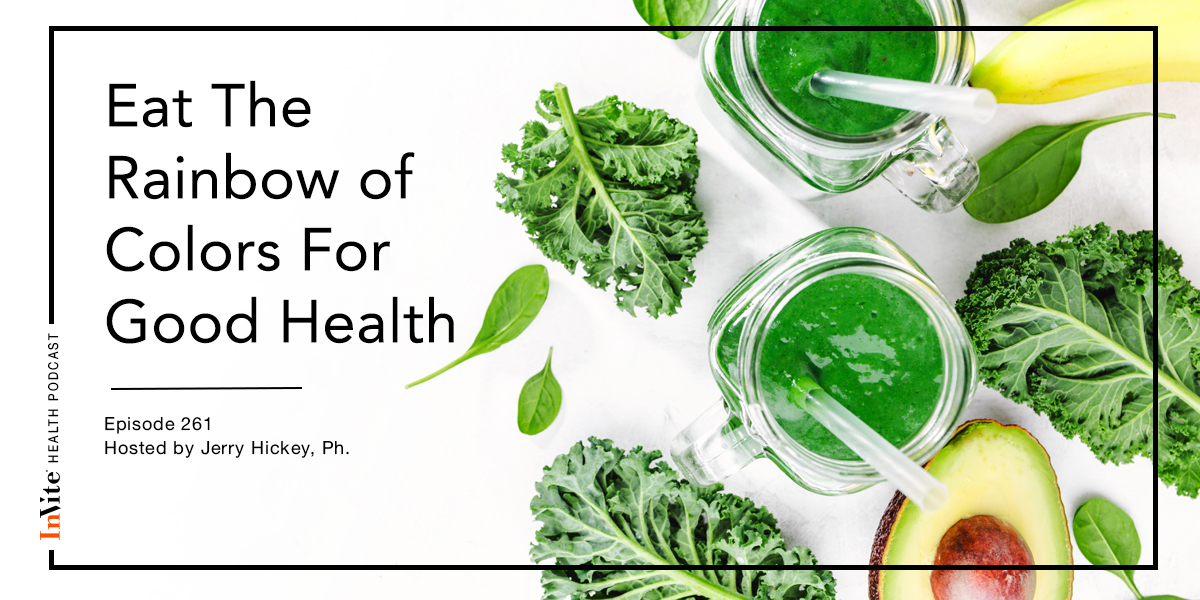Eat The Rainbow of Colors For Good Health – InVite Health Podcast, Episode 261

fruit
Invite Health Podcast, Episode hosted by Jerry Hickey. Ph
Subscribe Today!
To maintain our health and for better health, we need to focus on consuming the entire rainbow of colors offered by vegetables and fruits. More colors on our plates from fruits and veggies leads to better health. Additionally, we need to reduce our intake of salt, saturated fat and refined carbohydrates. We need to watch our red meat intake and when we do eat red meat, we need to remove any visible fat.
Why colorful foods are essential for your health
Foods should not be monotone. That’s really important. You have to introduce a range of plant-based colors. This gives your body protection. It’s the phytonutrients in the colors, which are the pigments in plants that have a lot of activities. Some of these are polyphenols, like resveratrol and silymarin. Others are carotenoids, like lycopene and lutein.
These nutrients are linked with a reduced risk of diabetes, some cancers, coronary heart disease, Alzheimer’s disease, poor immune system function and likely also autoimmune diseases. In general, they keep us healthy. They’re also connected to stronger bones, healthier skin and better vision. The list just goes on and on.†
Superfoods Offer Healthy Alternative To Fruit Juice – InVite Health Podcast, Episode 252. Listen Now >>
Focus more on the veggies with some fruit intake. Vegetables are low in sugar. Of course, some of them do have sugar like sweet potatoes, but they certainly have the benefits from the pigments in there. Fruits, in general, have more sugar, so I tell people you really want to have a plant-based diet focused more on vegetables and salads and then have a couple of servings of fresh fruits, especially citrus fruits, apples, pears and berries. They’re super healthy.
Some important and nutritious fruits, vegetables and pigments
Let’s look at some fruits vegetables that offer important and powerful pigments:
- Carrots: Carrots come in purples, reds and oranges, but they are typically seen as orange in the grocery store. That’s the beta carotene. Beta carotene is very important because it is converted into Vitamin A, which is important for the auditory processing part of the brain. Vitamin A is also needed to create barriers to infection. Beta carotene is needed for your skin, vision, immune system and red blood cell formation as well.†
- Green Veggies: Green veggies in general offer ingredients that help you detoxify. If you look at broccoli, cabbage or cauliflower, they have indole carbinols that are broken into diindolylmethane that has antiviral activity against things like herpes viruses. It also has some ability to protect sexual organs in women and men. Green vegetables also contain ingredients that stimulate the production of glutathione, which is the mother of all antioxidants in the body.†
- Yellow Veggies: Yellow veggies are really important for your vision and memory. You get zeaxanthin in yellow vegetables. Zeaxanthin is responsible for how quickly your brain processes information and it interacts with another carotenoid pigment called lutein to help you maintain your memory and great vision.†
- Reds: The reds in tomatoes, ripe guava, ripe papaya and strawberries come from lycopene, a very deep red pigment. Hundreds of studies have shown that lycopene is involved with lowering the risk of many cancers. It has also been shown to help prevent the age-related swelling of a man’s prostate and is great for keeping the arteries in the heart clean of plaque. Lycopene is also unbelievably protective for the skin, helping prevent damage from the sun’s ultraviolet radiation. There are also other reds, like the red in beets that comes from betacyanins and betalains. These are very powerful antioxidants that help restore circulation to an aging brain and are protective of the heart and circulatory system. Tart red cherries are full of anthocyanins and are remarkable for circulatory health.†
- Yellow/Oranges: You can get these pigments in butternut squash and cantaloupe. That’s a combination of lutein and zeaxanthin. These pigments are responsible for healthy vision and for memory functions.†
- Purples: You get purple pigments from berries. Ellagitannins, punicalagins and anthocyanins are really important for your brain health. They have antiviral activity, help protect you from radiation and are great for your circulation. Those purples like the blueberries, blackberries and raspberries are very important.†
- Cocoa: There are flavanols in cocoa that have been shown to help restore circulation to an aging brain. It’s good for your memory, mood and heart.†
- Green Tea: Green tea has catechins that have been shown to slow down the aging process. Older people that drink green tea have shown a decreased risk of developing frailty syndrome.†
- Whites: White foods can be confusing. There’s Mother Nature’s whites, including cauliflower, parsnips and white asparagus, that are loaded with good ingredients, but the man-made white processed foods, like instant oatmeal, white bread and white rice, are stripped of nutrients.†
How Superfoods Activate Antioxidant Pathways – InVite Health Podcast, Episode 247. Listen Now >>
Tune into the full podcast episode to learn more about these important nutrients and when it’s time to supplement.
Thank you for tuning in to the Invite Health Podcast. You can find all of our episodes for free wherever you listen to podcasts or by visiting www.invitehealth.com/podcast. Make sure you subscribe and leave us a review! Follow us on Facebook, Twitter and Instagram at Invite Health today. We’ll see you next time on another episode of the Invite Health Podcast.


